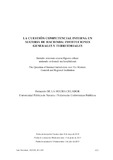Mostrar el registro sencillo del ítem
La cuestión competencial interna en materia de Hacienda: instituciones generales y territoriales
| dc.creator | Hucha Celador, Fernando de la | es_ES |
| dc.date.accessioned | 2020-04-22T08:02:49Z | |
| dc.date.available | 2020-04-22T08:02:49Z | |
| dc.date.issued | 2019 | |
| dc.identifier.issn | 1699-5376 | |
| dc.identifier.uri | https://hdl.handle.net/2454/36705 | |
| dc.description.abstract | El trabajo estudia las relaciones entre órganos internos de los territorios históricos del País Vasco y órganos generales de la Comunidad Autónoma del País Vasco en el plano estrictamente tributario, partiendo para ello del texto constitucional y de las normas aplicables (Concierto, leyes del Parlamento Vasco, normas forales, etc.). Un problema tradicional y aún no resuelto es el de las relaciones entre órganos, teniendo en cuenta que un porcentaje muy alto de los ingresos del País Vasco provienen de los territorios históricos. Ello demanda una normativa armonizadora para que no se produzcan asimetrías (que hay que corregir posteriormente) entre los tres territorios. En este sentido, se estudia igualmente la Ley (vasca) de 30 de 1989, que, teóricamente, intenta resolver este problema de difícil resolución. Y, para concluir una pregunta elemental sobre la que pivota el estudio, cual es el de la posibilidad de éxito de esta ley y la obligación de su cumplimiento por los territorios históricos, pese a que se trata de una ley de mínimos. | es_ES |
| dc.description.abstract | Lanak Euskadiko lurralde historikoetako barne-organoen eta Euskal Autonomia Erkidegoko organo orokorren arteko harremanak jorratzen ditu, zerga-ikuspegi zorrotzean; horretarako, konstituzio-testutik eta arau aplikagarrietatik abiatu da (Ituna, Eusko Legebiltzarraren legeak, foru-arauak, etab.). Betiko arazo bat –oraindik konpontzeke dagoena– organoen arteko harremanena da, kontuan izanik Euskadiko diru-sarreren ehuneko oso handi bat lurralde historikoetatik datorrela. Beraz, hiru lurraldeen artean asimetriarik ez egoteko –ondoren zuzendu egin behar dira–, araudi harmonizatzaile bat behar da. Ildo honetan, 1989ko maiatzaren 30eko 3/1989 Legea ere aztertzen da, teorian arazo konplexu hau konpontzen saiatzen dena. Amaitzeko, azterlanak ardatz duen galdera bat; hots, zein den lege honen arrakasta-aukera eta lurralde historikoek legea betetzeko obligazioa, nahiz eta gutxienekoen lege bat izan. | eu |
| dc.description.abstract | The paper examines the relationships between the internal agencies of the historical territories in the Basque Country and the more general agencies of the Basque Autonomous Community, doing so on a strictly tax-focused basis and starting from the text of the constitution and that of applicable regulations (Basque Economic Agreement, Laws of the Basque Parliament, Regional Laws, etc.). A traditional problem –and one that is still not solved– is that of the relationships between said agencies, taking into account that a very high percentage of the Basque Country’s income comes from the historical territories. This calls for a harmonisation of laws to avoid asymmetries (which need to be subsequently corrected) among the three territories. To that end, the (Basque) Law 3/1989 dated May 30 of 1989, which, theoretically, aims to solve this complicated problem is also studied. And, to conclude, an elementary question around which the study revolves: that of this law’s possibility for success and the obligation for the historical territories to comply therewith despite the fact that it is a law of minimums. | en |
| dc.format.extent | 37 p. | |
| dc.format.mimetype | application/pdf | en |
| dc.language.iso | spa | en |
| dc.publisher | FEDHAV | es_ES |
| dc.relation.ispartof | Iura Vasconiae, 16/2019, 413-449 | es_ES |
| dc.rights | CC Reconocimiento-NoComercial-SinObraDerivada 4.0 Internacional (CC BY-NC-ND 4.0) | es_ES |
| dc.rights.uri | http://creativecommons.org/licenses/by-nc-nd/4.0/ | |
| dc.subject | Comunidad Autónoma Vasca | es_ES |
| dc.subject | Territorios históricos | es_ES |
| dc.subject | Tribunal Constitucional | es_ES |
| dc.subject | Soberanía tributaria | es_ES |
| dc.subject | Potestades tributarias | es_ES |
| dc.subject | Armonización tributaria | es_ES |
| dc.subject | Asimetrías en las aportaciones | es_ES |
| dc.subject | Euskal Autonomia Erkidegoa | eu |
| dc.subject | Lurralde historikoak | eu |
| dc.subject | Konstituzio Auzitegia | eu |
| dc.subject | Zerga-burujabetza | eu |
| dc.subject | Zerga-botereak | eu |
| dc.subject | Zerga-harmonizazioa | eu |
| dc.subject | Asimetriak ekarpenetan | eu |
| dc.subject | Basque Autonomous Community | en |
| dc.subject | Historical territories | en |
| dc.subject | Constitutional Court | en |
| dc.subject | Tax sovereignty | en |
| dc.subject | Taxing powers | en |
| dc.subject | Tax harmonisation | en |
| dc.subject | Tax contribution disparities | en |
| dc.title | La cuestión competencial interna en materia de Hacienda: instituciones generales y territoriales | es_ES |
| dc.title.alternative | Barneko eskumen-arazoa Ogasun-arloan: erakunde orokorrak eta lurraldekoak | eu |
| dc.title.alternative | The question of internal jurisdiction over Tax matters: general and regional institution | en |
| dc.type | info:eu-repo/semantics/article | en |
| dc.type | Artículo / Artikulua | es |
| dc.contributor.department | Derecho | es_ES |
| dc.contributor.department | Zuzenbidea | eu |
| dc.rights.accessRights | Acceso abierto / Sarbide irekia | es |
| dc.rights.accessRights | info:eu-repo/semantics/openAccess | en |
| dc.type.version | info:eu-repo/semantics/publishedVersion | en |
| dc.type.version | Versión publicada / Argitaratu den bertsioa | es |



